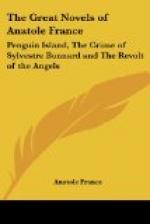This admirable intensity of thought may seem excessive in the case of an annalist who applies himself to relate the events of his own time. However abstracted and detached we may be from surrounding things, we nevertheless resent their influence. I have consulted the original manuscript of Johannes Talpa in the National Library, where it is preserved (Monumenta Peng., K. L6., 12390 four). It is a parchment manuscript of 628 leaves. The writing is extremely confused, the letters instead of being in a straight line, stray in all directions and are mingled together in great disorder, or, more correctly speaking, in absolute confusion. They are so badly formed that for the most part it is impossible not merely to say what they are, but even to distinguish them from the splashes of ink with which they are plentifully interspersed. Those inestimable pages bear witness in this way to the troubles amid which they were written. To read them is difficult. On the other hand, the monk of Beargarden’s style shows no trace of emotion. The tone of the “Gesta Penguinorum” never departs from simplicity. The narration is rapid and of a conciseness that sometimes approaches dryness. The reflections are rare and, as a rule, judicious.
V. THE ARTS: THE PRIMITIVES OF PENGUIN PAINTING
The Penguin critics vie with one another in affirming that Penguin art has from its origin been distinguished by a powerful and pleasing originality, and that we may look elsewhere in vain for the qualities of grace and reason that characterise its earliest works. But the Porpoises claim that their artists were undoubtedly the instructors and masters of the Penguins. It is difficult to form an opinion on the matter, because the Penguins, before they began to admire their primitive painters, destroyed all their works.
We cannot be too sorry for this loss. For my own part I feel it cruelly, for I venerate the Penguin antiquities and I adore the primitives. They are delightful. I do not say the are all alike, for that would be untrue, but they have common characters that are found in all schools—I mean formulas from which they never depart—and there is besides something finished in their work, for what they know they know well. Luckily we can form a notion of the Penguin primitives from the Italian, Flemish, and Dutch primitives, and from the French primitives, who are superior to all the rest; as M. Gruyer tells us they are more logical, logic being a peculiarly French quality. Even if this is denied it must at least be admitted that to France belongs the credit of having kept primitives when the other nations knew them no longer. The Exhibition of French Primitives at the Pavilion Marsan in 1904 contained several little panels contemporary with the later Valois kings and with Henry IV.




